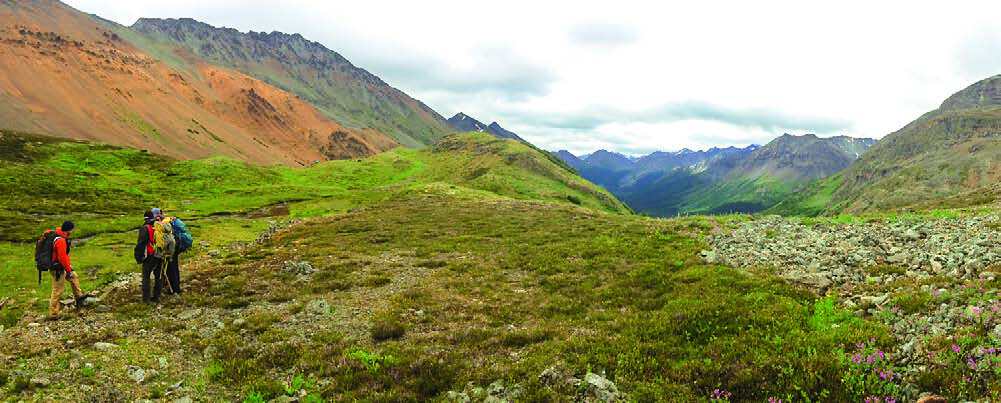A geological map of British Columbia looks a little like the end of a rainbow: bold swaths of colour run up and down the province, representing thick belts of rock pressed together by the constant movement of the Pacific Plate under the North American continent. And B.C. has the pots of gold – and copper, silver and molybdenum – to prove it.
Squeezed in the middle is the Quesnel terrane, also known as Quesnellia, a depositional belt 1,500 kilometres long and 30 to 100 kilometres wide that spans the length of B.C., from the southern U.S. border to near Dease Lake in the northwest of the province. Like all of B.C.’s geologic terranes, it is separated from neighbouring belts by a series of generally northwest-trending regional thrust and strike-slip faults.
The Quesnel terrane is a complex package of plutonic, subaqueous to subaerial coherent and fragmental volcanic and volcanic-derived sedimentary rocks. These rocks were deposited in a volcanic island arc setting during the Mesozoic era, and are Late Triassic to Early Jurassic in age.
They were accreted onto the continental margin as the oceanic Pacific plate was subducted beneath the western edge of ancestral North America around 240 to 180 million years ago. Since then, the continued overall northwestward drift of the North American plate has caused mountain belts to build and faults to form, and has positioned the continent for more geologically recent glaciation.
Quesnellia’s riches
The Quesnel terrane is important particularly for porphyry-type ore deposits. The terrane hosts a number of known deposits and mineral prospects, mainly porphyry copper-gold with silver and/ or molybdenum. These are subvolcanic intrusion-related ore deposits hosted in mafic to intermediate volcanic rocks of the Takla or Nicola Group, and in associated plutonic rocks. The main intrusive batholiths associated with deposits include, from south to north, Guichon Creek (Highland Valley mine), Iron Mask (New Afton mine), Takomkane (Woodjam prospect), Granite Mountain (Gibraltar mine) and the Hogem intrusive complex (Mt. Milligan mine).

Recent studies by James Logan and Mitchell Mihalynuk of the BC Geological Survey have shown the geochemistry of the plutons and related porphyry deposits transitions from an older calc-alkaline series of copper-molybdenum deposits in a western arc-parallel belt (e.g., Highland Valley and Gibraltar) to a younger, more alkaline series of copper-gold deposits in an eastern belt (e.g., Copper Mountain, New Afton, Mount Polley and Mt. Milligan). This is thought to reflect an eastward migration of Mesozoic arc magmatism from the central part of the arc towards a more back-arc setting over time.
North-central B.C.: Hosted by the Hogem
In the Quesnel terrane of north-central B.C., exploration for porphyry coppergold deposits is generally focused on the Hogem intrusive complex (HIC) or along its margins, and largely within the Omineca Mountains. In 2015, exploration activity advanced several prospects.
The Kliyul copper-gold porphyry prospect, a partnership between Kiska Metals Corporation and Teck Resources Limited, is hosted in diorite intrusive rocks and Takla Group volcanics off the northern margin of the HIC. Drilling in 2015 successfully expanded the potential of the deposit, which remains open in multiple directions. Kiska Metals Corporation is also developing drill targets within the historic BP Zone at its Chuchi prospect, an area of known mineralization, open in three directions and at depth.
In 2015, Pacific Empire Minerals Corp. drilled geophysical targets at Col-Later at an inflection point and margin of the HIC. Serengeti Resources Inc. drilled on its Kwanika group of properties where additional drilling is planned for 2016 on the Kwanika copper-gold silvermolybdenum porphyry system near the terrane-bounding Pinchi fault. Thane Minerals Inc. was actively conducting grassroots work at Cathedral, and Garibaldi Resources Corp. completed grassroots work on the Red Lion property contiguous with Kliyul. Southeast of the HIC in Takla Group volcanics, Thompson Creek Metals Company Inc. was exploring its North Grid prospect, which has a similarу geophysicalgeochemical signature to the mineralized stocks at the nearby Mt. Milligan mine.
The only operating mine in the northcentral Quesnel belt in 2015 was Mt. Milligan, a conventional truck-shovel open-pit copper and gold mine, located 160 kilometres northwest of Prince George. The mildly alkalic porphyry deposit is approximately 2.5 by 1.5 kilometres in area and 400 metres deep, and is hosted by Takla Group volcanics. The mine, commissioned in October 2013, is currently operated by Thompson Creek Metals with a workforce of about 450 employees and an estimated mine life of 24 years.
The Mt. Milligan and more alkaline Lorraine deposit (Lorraine Copper Corp., Teck Resources Limited) further north in the HIC are both closely related to regional syenite (high-potassium) intrusions and the Chuchi Lake and Duckling Creek events. They are also slightly younger (late Early Jurassic era) than the main pulse (at the end of the Triassic era) of porphyry copper mineralization in B.C. They are closely associated in time with the final stage of emplacement of the Quesnel island arc onto the continental margin.
Northwest B.C.: Grassroots exploration
In the Quesnel terrane of northwest B.C., exploration for porphyry type mineralization is currently focused east of Dease Lake at the Eaglehead project of Copper Fox Minerals Inc. and Carmax Mining Corp., where drilling is testing geophysical anomalies in granodioritic intrusive rocks.
North of Dease Lake, Gold Jubilee Capital Corp. is working at the Pyramid project, hosted in a diorite phase of a multi phase intrusive complex.
South-central B.C.: Operations and potential
The Quesnel terrane of south-central B.C. hosts five operating mines including, from north to south, Gibraltar (Taseko Mines Limited, open pit), Mount Polley (Imperial Metals Corporation, open-pit and underground), New Afton (New Gold Inc., underground), Highland Valley Copper (Teck Resources Limited, open-pit) and Copper Mountain (Copper Mountain Mining Corp. and Mitsubishi Materials Corp., open-pit). Individually, these mines have workforces ranging between 220 and 1,300 employees, and cumulatively have about 76 years of mine life.
Exploration-stage projects in south-central B.C. for porphyry-type mineralization include the proposed Ajax mine of KGHM Ajax Mining Inc. near Kamloops. The mine has a projected life of 18 years and a workforce of 350 permanent jobs. Mineralization at Ajax is associated with the Sugarloaf diorite intrusive phase of the Iron Mask batholith.
EnGold Mines Ltd. drilled the Aurizon South breccia zone on its Lac La Hache project in 2015 and discovered the Berkey copper mineralized zone through prospecting. The property is underlain by the multi-phase alkaline Spout Lake intrusive complex and Nicola Group volcanic rocks. Near Kamloops, Tower Resources Ltd. announced the discovery of two new coppergold targets, Kwil and KV, on its Rabbit North project, where copper mineralization is associated with the Durand Lake pluton. Near Merritt, Plate Resources Inc. drilled the Lucky Mike copper-tungsten skarn mineralization, hosted in Nicola Group volcanics and thought to be associated with a broad porphyry molybdenum-copper system.
Despite a number of tough years for the industry, B.C.’s exploration and mining industry remains resilient. With seven operating mines, numerous encouraging prospects and strong support from researchers, government and explorers, the Quesnel terrane continues to grow its reputation as a highly prospective belt – particularly for porphyry type ore deposits – for explorers in Canada and globally.
Тhe author thanks Paul Jago, regional geologist with the B.C. Ministry of Еnergy and Mines, for his generous contributions to this article.
